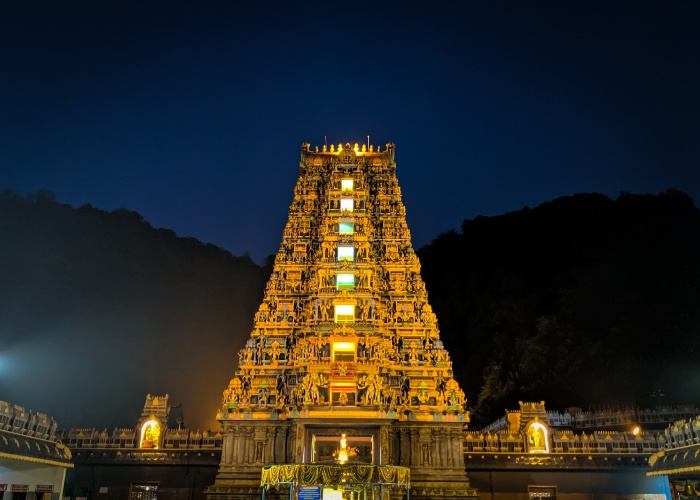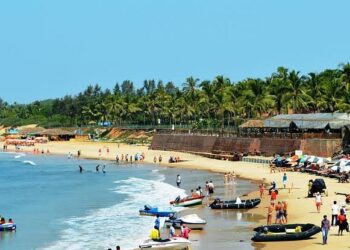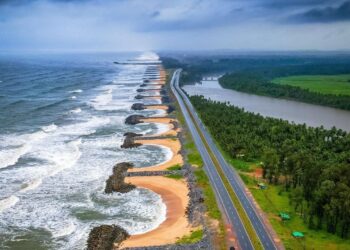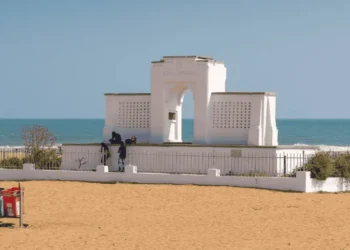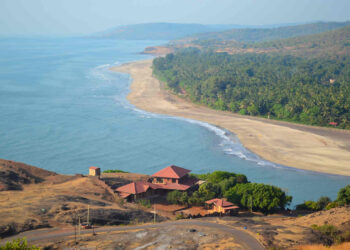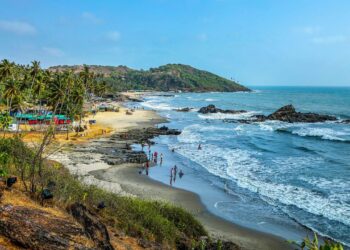The Kanaka Durga Temple in Vijayawada, Andra Pradesh, shines as a special temple dedicated to Goddess Durga, the city’s guardian. Set on Indrakeeladri Hill by the Krishna River, this 8th-century shrine showcases tall Dravidian gopuram, carved stones, and mother Durga’s intense energy drawing feel pilgrims, history lovers, and travelers from all across India.
Legend of the Temple
The Kanaka Durga Temple is steeped in old tales. One key story comes from the Devi Mahatmyam, a sacred text of Shakti. Long ago, a demon named Mahishasura grew too strong, creating havoc in the universe and for the gods. They prayed to the Mother Goddess, who took the form of Durga and fought him for nine days on this hill. On the tenth day, she defeated him, earning the name Mahishasura Mardini. The temple honors her victory, and locals believe she still protects Vijayawada. Another tale tells of a Chalukya king in the 8th century who saw Durga in a dream, commanding him to build her a shrine. He obeyed, and the city grew safe, making Kanaka Durga, the “Golden Goddess,” a beloved protector watching over the land.
History of the Kanaka Durga Temple
The temple’s roots go back to the 8th century, likely started by the Chalukyas, though some say worship began far earlier. A stone writing from 800 CE nearby hints at a holy site here, but the temple we see took shape under Chalukya rule. Old records show priests kept rituals going strong. By the 12th century, Chola kings added halls and carvings, as temple stones tell. The Vijayanagara kings, ruling from the 14th to 16th centuries, gave gold and land, making it a big spiritual spot. In the 1700s, local chiefs, like the Machilipatnam rulers, helped fix the hill steps, old writings say.
The temple stayed lively through centuries, with farmers, traders, and devotees keeping it strong, as per Vijayawada’s old logs. In 1858, British rule came, but the temple’s rituals held firm. After 1947, Andhra’s government took over, and the Endowments Board now runs it. Telugu songs by saints like Annamacharya, who sang for Durga, spread her fame, tying the temple to Andhra’s Bhakti ways. As a Shakti shrine, it pulls thousands seeking her strength and grace.
Architecture of the Temple
The Kanaka Durga Temple, spread over 3 acres, shows Dravidian style with Chalukya touches. Its seven-story gopuram, 30 meters high, is covered with carvings of Durga’s battles, dancers, and lion-like yalis, painted in soft reds and whites. A wooden door, carved with gods, leads to the sanctum, where the 8th-century black stone idol of Kanaka Durga glows with gold and silk. A small shrine for Malleswara Swamy, a Shiva form, sits close, built in 1200 CE. The main prayer room, fixed in the 1500s, has stone pillars with Devi Mahatmyam scenes and Chalukya marks.
The navaranga hall, with 12 pillars, shows Ramayana tales and Vijayanagara signs. A holy tank, Indra Pushkarini, lies in the courtyard for washing before prayers. Shrines for Ganesha and Subrahmanya are nearby. Wall carvings from the 1400s, kept by the ASI, show Durga’s win over demons, making every stone a piece of history. The temple’s hilltop spot, looking over Vijayawada’s river and homes, ties it to the city’s past as a trade hub, near spots like the Undavalli Caves.
Festivals and Rituals
The temple glows during festivals, especially Navratri in September or October, a nine-day event dedicated to the Goddesses. Each day, Mother Shakti takes a new form, like Mahakali or Saraswati, with priests worshipping her differently on each day. On Vijayadashami, the tenth day, a procession with music honors her victory, drawing thousands. Maha Shivaratri brings all-night prayers, and Deepavali lights the hill with lamps.
Telugu bhajans and Bharatanatyam dances, telling Durga’s tales, fill the air. Navratri’s Kumkum Archana, a special puja, mixes faith and joy, as locals share stories of Durga’s grace.
Old tales say Indra, a god, gave the hill its name, Indrakeeladri. The Malleswara shrine draws Shiva worshippers, joining both Shakti and Shiva paths.
Getting to the Temple
Vijayawada is easy to reach. Vijayawada Airport, 20 km away, has flights from Hyderabad (1 hour) or Chennai (1.5 hours). Taxis take 30 minutes to the temple. Local autos cost 20-50 rupees to the temple. No entry fee, but pujas may cost 100-300 rupees.
Nearby Attractions
The Krishna River offers peaceful walks or boat rides for 50-100 rupees, showing Vijayawada’s green sides. Bhavani Ghat, 2 km away, is a calm spot for prayer or evening views. The Undavalli Caves, 8 km away, are 4th-century caves with Vishnu carvings, reached by auto for 200 rupees. Prakasam Barrage, 3 km away, is a pretty bridge for walks, free to see. The Gandhi Hill Museum, 4 km away, has old photos for a 20-rupee entry, adding history to the temple visit.
Practical Tips for Visiting
Andhra Pradesh gets quite hot, up to 40 degree Celsius, with rains from June to September. November to February is cooler. Visit early in the morning to avoid crowds and heat. Wear clothes covering shoulders and knees; saris or salwars work best for women and dhoti for men. Navratri is crowded, so book hotels and pujas early. Carry water and a hat for the hill steps. Autos from Vijayawada cost 20-50 rupees.
Final Thoughts
The Kanaka Durga Temple is a shakti kshetra for Bhagawati who showers grace and protection to her devotees calling thousands of Hindus from all across India. It is a must visit if you’re visiting Vijayawada.
